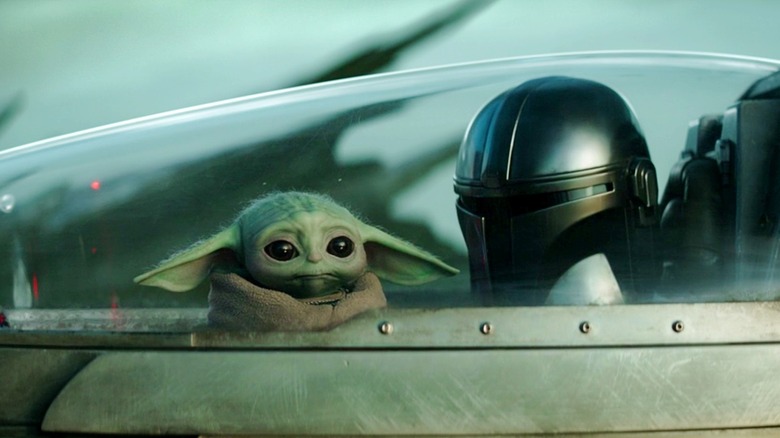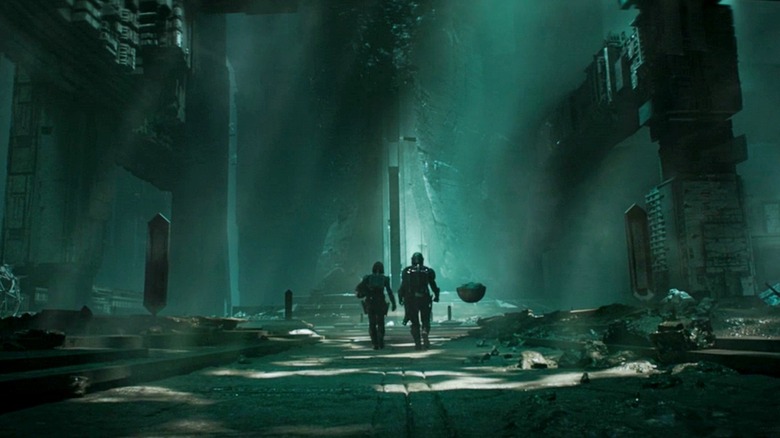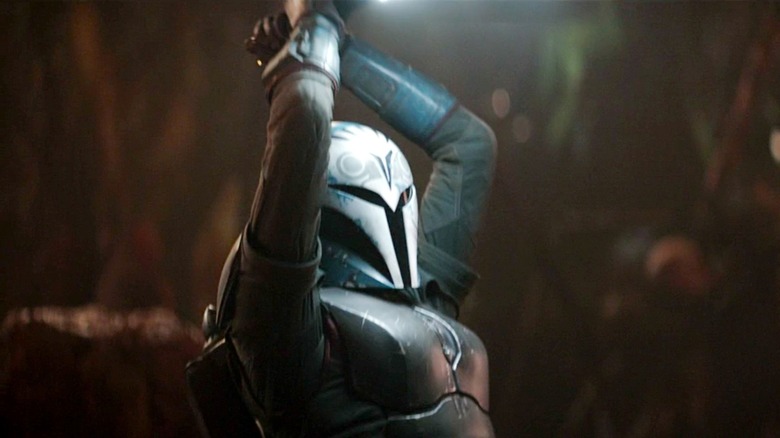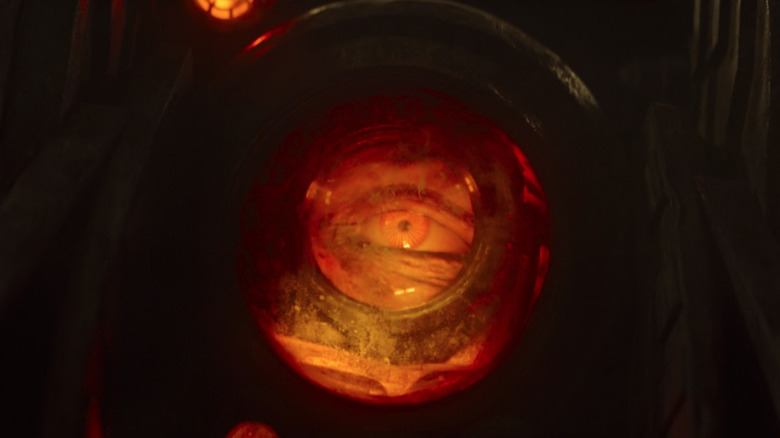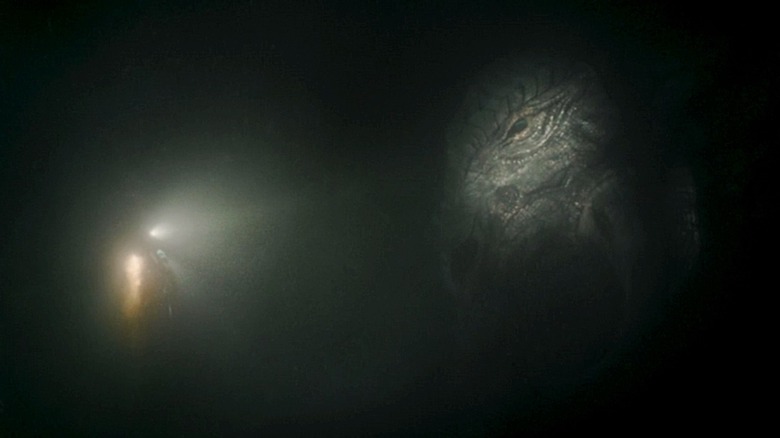The Mandalorian's Mines Of Mandalore Offers Up Surprises Galore
This post contains major spoilers for the second episode of "The Mandalorian" season 3.
The latest episode of "The Mandalorian" picks up where the last left off, with Din Djarin (Pedro Pascal, et al) on his quest to get parts for IG-11 so that he may go to the surface of Mandalore and find out if it's toxic. Naturally, this brings him to Peli Motto (Amy Sedaris) on Tatooine during the Boonta Eve holiday. When she consults the Jawas and discovers that a chip for IG-11 isn't going to be found anywhere, she convinces him to take an astromech droid, R5, with him to Mandalore to get on with his quest. The Mandalorian reluctantly agrees and heads straight to Sundari city with Grogu, hoping to find the Civic Center and the Mines of Mandalore beneath it. After fighting off a group of indigenous monsters and discovering the air is not poisonous, Din and Grogu descend into the bowels of the shattered city, looking for the living waters in the mines of Mandalore so that Din can atone for his transgressions.
Things would be going well enough for Din and Grogu, except for the fact that Din falls into the trap of a menacing cybernetic creature, is locked in a cage, and is quickly hooked up to a machine to steal his blood. Grogu tries to rescue him, but Din instead tells him to get Bo-Katan. Dutifully, Grogu makes his way back to the N1 and, with the help of R5, navigates to Bo-Katan.
When she sees Din's ship approaching, she wants to tell him off but grows unusually concerned when she finds he's missing and Grogu is alone. She loads Grogu and R5 into her own ship and races to Mandalore to save Din. She's able to destroy the monstrous cyborg, using the Darksaber to do it, and then offers to lead Din to the living waters herself.
When Din goes to baptize himself, he sinks into the deep parts of the water, forcing Bo-Katan to rescue him again. But in the deep places of Mandalore, they find something else slumbering ... something they did not expect. A mythosaur.
The Mines of Mandalore
"Star Wars" is no stranger to having the motifs and ideas from "The Lord of the Rings" filter their way into it. And anyone who knows that will have no trouble seeing the similarities between the Mines of Mandalore and the Mines of Moria, as seen in "The Fellowship of the Ring." The Mines of Moria had always been a cautionary tale about delving too greedily into the mines, and seeing the beskar mines in the state their in certainly helps draw that parallel. If we take the reference one step further, does that make the mythosaur the Balrog? Will it kill Din Djarin (or even Bo-Katan?) and have them return as something greater?
It seems like a distinct possibility if we go back to what the Armorer told Din Djarin in "The Book of Boba Fett." She said, "The songs of eons past foretold of the mythosaur rising up to herald a new age of Mandalore."
As far as anyone knew, mythosaurs had been extinct for ages. What could this possibly mean for our hero? Is this truly meant to usher in a new era for Mandalore?
In the mythological sense of these events, Din Djarin is essentially taking on a second baptism. In mythologies past and present, the submersion beneath the water for the baptism symbolizes trust and reliance in the ideal or deity they're being baptized in the name of. And it's no mistake that we saw a Mandalorian helmet ceremony follow along these same lines in the first episode, and the attack of that creature is a visual tie to the mythosaur here. The Mandalorians belong on Mandalore, and the natural world is trying to tell us that in the symbolism of the story.
Bo-Katan
Bo-Katan takes an interesting turn in this episode, and we get to see a change in her. When she first sees Din's ship arriving at her castle, she's ready to tell him off. When she realizes it's Grogu by himself, she's instantly concerned. Is this concern for Din? Or is it concern for where the Darksaber might be? Is she going to save him on the off chance he's dead and she can just take the Darksaber? Or out of genuine care?
Her motives are unclear, but, for better or for worse, she does seem to be truly invested in helping. She also offers a stark contrast against Din Djarin. When Din is forced to dispatch the amalites — the creatures who attack them at the mouth of the cave they enter Sundari city — he struggles. There's a clumsiness to his fighting style. When Bo-Katan is forced to do the same thing, she does so much more elegantly and easily. And later, when she picks up the Darksaber to dispatch the cyborg creature, she has a fluidity to it that doesn't have that same weight that Din is forced to struggle with. There's still something locked up inside of him, preventing him from using it with ease.
My favorite moment with Bo-Katan in this episode, though, is the exchange between the two of them. When she reveals that her father was a great man and gave his life for Mandalore, the response she gets from Din is touching. "This is the way," he tells her, showing that he's learning more and more about what it might take to be a real Mandalorian.
Details to watch out for
One of the first nods to other "Star Wars" lore comes in the opening moments of this episode. When Peli Motto is scamming that poor Rodian, she hammers the fact that she shouldn't even be working since it's Boonta Eve. Boonta Eve is the Hutt holiday the podrace in "The Phantom Menace" was held on. Sadly, Anakin Skywalker didn't get to stay long enough to see the fireworks.
Peli also uses the phrase "Leaping like a Lurmen," which is a reference to the Lurmen species seen in "The Clone Wars." They're a peaceful race of mammal-like creatures that looked like a cross between raccoons and squirrels from the planet Mygeeto. You can see more of them in the episodes "Jedi Crash" and "Defenders of Peace" in the first season.
Another phrase Peli uses refers to chance cubes, like the one Watto lost Anakin Skywalker within "The Phantom Menace."
As Din Djarin, Grogu, and later Bo-Katan descend into the undercity of Sundari, these pipes and trail areas look an awful lot like the parts of the undercity that Maul drew Ahsoka Tano to in the final arc of "The Clone Wars," in the final hours leading up to Order 66.
There are no confirmations of it at press time, but Phil Tippet is credited on this episode as a visual design consultant, and it looks like his work was likely directed at the cyborg creature. It has a stop-motion look about it, and feels very much like the sort of weird stuff he would do. The energy weapon the cyborg uses, too, looks as though it might be related to the superweapon that Sabine Wren created for use against the Mandalorians, though that's just speculation also.
The mythosaur is the biggest jaw-drop reference in this episode, though. Mythosaurs have not been seen in a living form in "Star Wars." They've always been seen as bones or drawings, and as symbols of Mandalore. A live one means a lot for the Mandalorian people and Din is going to have to deal with that sooner than later.
Coda
This episode felt like an equal mix of "Lord of the Rings" and a horror movie, and I mean both of those things in a good way. The cyborg creature is one of the coolest things we've seen on this show, and makes me believe that Jon Favreau and the other producers are doing everything they can to maximize the budget they've been given on this show.
As far as episodes, too, this is a vast improvement over the premiere episode. Not that I didn't like the first episode of the season — but it felt like a lot of table-setting. This episode really kicked things into high gear and gives us a very clear picture of the troubles we're going to see Din Djarin tackle over the course of the season.
He's going to have to deal with the prophecies of Mandalore. He's going to have to deal with Bo-Katan one way or the other. The mythosaur's resurgence is going to change the lives of every Mandalorian, as is the knowledge that Mandalore's atmosphere is breathable. Since the Empire is largely gone by this point, and the New Republic has taken over, what is standing in their way from coming back and rebuilding?
The thing I liked most about this episode, though, was the pluralism that Din Djarin continues to take to heart, questioning the beliefs that he has and challenging them against the people that he meets. When he first met Bo-Katan, he was shocked she removed her helmet, and in this episode he tells her with reverence, "This is the way." Can he unite Mandalore and all of its sects? Only time will tell.
"The Mandalorian" is streaming only on Disney+. New episodes release every Wednesday.
